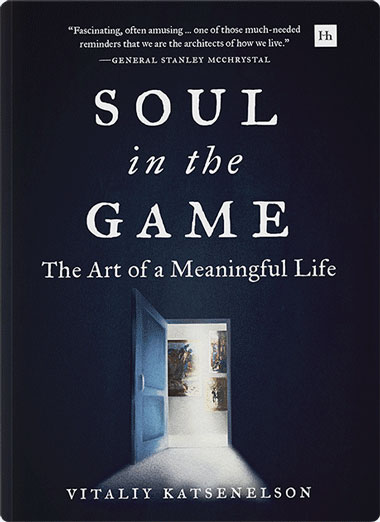“Fascinating, often amusing… one of those much-needed reminders that we are the architects of how we live.”
General Stanley McChrystal
Author, Risk, A User’s Guide
My company, IMA, is an investment advisory firm. We are longterm value investors. We analyze companies as any intelligent businessperson would, with the intention of owning them for years. When we find undervalued companies (stocks), we buy them, but we have no idea how the stock market will price them tomorrow or a few months from now.
When IMA was small, we were hired by a large client. We told him up front what we did, and he also read our 30-page brochure. It seemed like a match made in heaven – until a few months into our relationship, when I realized that he was measuring our performance on a weekly basis. (Remember, we were looking years out.)
Today, I’d have a conversation with this person and explain that what we do is likely not for him, and I’d gently ask him to reevaluate his time horizon or his relationship with us.
Then, we could not afford to be too choosy. But I instinctively started practicing negative visualization (though I didn’t call it that at the time). I visualized how we lost this client. Most importantly, I managed the firm as if this client was already gone. I did not have to visualize for very long – he left after four months. When he left, the pain did not sting as much as it might have. I was mentally and financially prepared.
This is what negative visualization is: imagining and contemplating bad things happening before they happen. It is like being vaccinated against an adverse future. You already visualized it, and your mind has had a chance to pre-adapt to it. As Seneca explains, “He robs present ills of their power who has perceived their coming beforehand.”
There is another reason to practice negative visualization – it enhances your appreciation of what you have. I wrote in “Born in Russia, Made in America” how after my mother’s death I inadvertently, out of fear and trauma of recent experience, visualized losing my father. This increased my appreciation of my father from a young age and made our relationship stronger and more meaningful.
Since my mother passed, I have never practiced negative visualization when it comes to the deaths of friends or family (it’s simply too painful). I did visualize my kids growing up and going off to college, and that helped me appreciate the limited time I have with them under the same roof. Once you realize that everyone (and everything) around you is transitory, you value people and things a lot more. This may improve the relationships you have with people you love, by encouraging you to treasure those relationships.
I want to make one point clear – negative visualization does not mean we constantly dwell on negatives, thinking about bad things happening to us. For instance, I do not dwell on the fact that my kids will grow up, leave home, and have their own lives. Instead, negative visualization tells me that I need to free myself from the computer screen and refocus my attention (the currency of time) on them – be it going for a bike ride, a trip to a bookstore, skiing, or simply having a dinner conversation without constantly looking at my smartphone. Then a potential negative becomes a real-time positive.
Negative visualization can spur us to positive action, helping us to deal with stress and reduce suffering in real time. Imagine this. You are driving home, there is dinner waiting for you on the table, and you find yourself stuck in traffic. You are doing positive visualization as your mind is comparing two activities: sitting in a metal box on wheels, idling in the traffic, versus eating dinner. Idling in the box is less appealing than the alternative. You get stressed – unnecessary negative emotions spike and your happiness declines. I am sure this did not require much imagination. All of us go through this all the time.
This is when the EJR frameworks kicks in. Stuck in traffic – the event. Judgment – we have several options. We can do negative visualization. Instead of doing positive visualization, comparing our idling in traffic to the warm meal and glass of wine that awaits us, we can visualize that things could have been so much worse. We could have been driving back from a doctor’s appointment after he told us we had only have two weeks to live. Suddenly, arriving home 30 minutes late doesn’t feel so bad.
Here are a few more examples. I had a conversation with a friend. He is a widower who had recently started dating. A woman he really liked had broken up with him. He said he was depressed and lonely. I told him, think about it. You are in your 70s. You have good health. You have kids that love you, and they are all healthy and have good lives. You have a lot of friends. You are financially independent: you may not be flying on private planes, but you don’t have to worry about the price of tomatoes at the grocery store. Even your football team did well last year. Imagine that you lost all that. Is your life now so bad? He paused and really thought about it, then said, “Yeah, not so bad.” I saw glimpses of a smile on his face. (Note to self – it is easy to dispense advice to others; I need to remember to follow my own advice.)
Another friend told me a story. He was at the airport, standing at the checkout counter. There was a man in front of him who looked like a soldier coming home from a tour in the Middle East. My friend overheard the airline representative telling him that the airline had lost his bag. The soldier calmly and quietly replied, “Well, that’s okay, nobody died.” It is not difficult to imagine how trivial losing a bag might be when you have faced death in combat, when you have seen your friends blown to pieces by roadside bombs. This soldier did not have to theoretically practice negative visualization; he had lived it. It was seared into him. And it gave him a clear, strong perspective on what is important and what is trivial.
Speaking of trivial. I’ve been practicing negative visualization for years with my wife and did not even know it. My wife is not a big spender. Whenever I buy something that she did not ask me to buy, she gives me a questioning look and says, “How much was that?” If it was $100, I triple the price and say $300. Her eyes widen and she says “$300!?! That’s too much!” Then I say, no, it was actually just $100. I anchored and tricked her mind to negatively visualize $300 just for a second, and suddenly $100 seems like a bargain. I know that with this little piece of advice I just saved thousands of marriages. You’re welcome.
Last point.
Now we can explain, from a Stoic perspective, why social media makes us miserable, while watching reality shows about dysfunctional people makes us happy (shows about hoarders, family feuds, or cheating spouses come to mind here).
Social media results in positive visualization (longing for things we wish we had). People don’t put their miserable moments on social media – those moments when they have a fight with their spouse, their kids are throwing tantrums, or their house looks like a hurricane went through it. No, our friends share their best picture- and video-perfect moments, when their houses look like model homes, their kids are adorable, and their spouses are smiling and loving.
You’d think seeing your friends’ happiness would brush off on you and make you happy. Wrong! Your subconscious kicks in and starts comparing your ordinary life with your friends’ never-ending smiley paradise. You feel like you don’t measure up.
Reality TV featuring dysfunctional people, on the other hand, fires up the negative visualization. We realize that our lives could have been so much worse, like those people on TV.
What would the Stoics say about social media and reality shows?
Seneca would probably remind us of the preciousness of time (as he will in a few chapters). He would not be a fan of social media or reality TV. Epictetus would quote himself: “Most of us would be seized with fear if our bodies went numb, and would do everything possible to avoid it, yet we take no interest at all in the numbing of our souls [and minds].” Marcus would meditate on this in his journal and decide that there is no point engaging in activity that ultimately makes us miserable.
None of them would suggest that we start gulping reality TV as an antidote to social media. Instead, they’d suggest we’d learn to appreciate what we have by imagining our lives without it.
I’ll let Marcus finish this chapter: “Do not indulge in dreams of having what you have not, but reckon up the chief of the blessings you do possess, and then thankfully remember how you would crave for them if they were not yours.”

Dubbed “the new Benjamin Graham” by Forbes, Vitaliy is the CEO of a value investing firm, author of several books, and a prolific writer on topics as diverse as investing, parenting, classical music, and self-improvement. You can read his articles at Investor.fm or listen to them on his podcast, The Intellectual Investor.
“Fascinating, often amusing… one of those much-needed reminders that we are the architects of how we live.”
General Stanley McChrystal
Author, Risk, A User’s Guide
“Soul in the Game is a beautiful way to search for the lost value of happiness, strength and health.”
Wim Hof
Author, The Wim Hof Method

“Vitaliy knows how to tell a story. This book reads like a conversation with Vitaliy: deep, insightful, inquisitive and civilized.”
Nassim Nicholas Taleb
Author, The Black Swan
“Vitaliy Katsenelson has been singled out by financial media for his brilliant investment strategies, but perhaps even more impressive are his philosophical writings.”
Carl Bernstein
Author, All the Presidents Man
Leave a review and send a link or a screenshot of the review to bonus@soulinthegame.net to receive 6 new pieces (35 pages of content!)